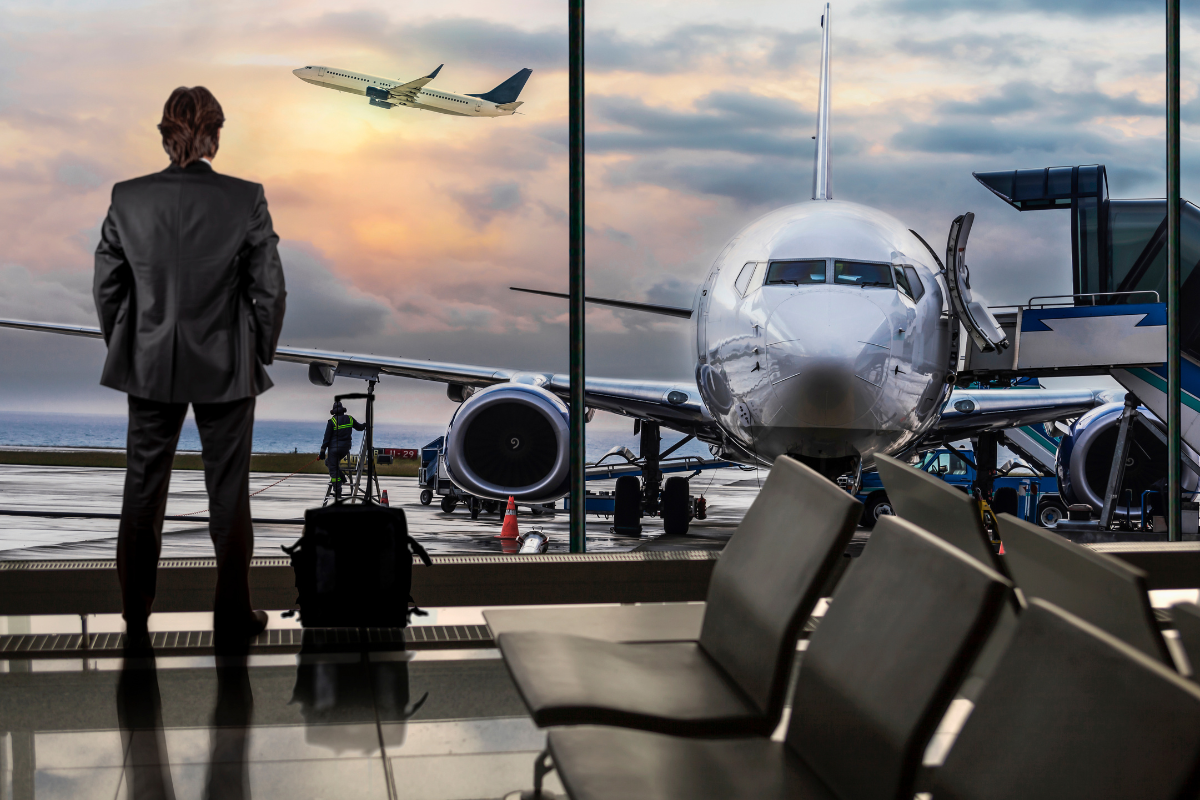How Early to Arrive for a Domestic Flight in Canada
By Arthur Dubois | Published on 27 Sep 2023

Traveling by air can be both exciting and stressful. One aspect that can cause anxiety is figuring out how early to arrive for a domestic flight in Canada. The last thing you want is to rush through security or risk missing your flight. In this article, we’ll explore everything you need to know about check-in times, why the recommended arrival time is usually 1-2 hours before a domestic flight, the impact of peak travel times, how to navigate Canadian airports efficiently, and how to deal with unexpected delays. So, let’s dive in and make your next domestic flight a breeze!
Understanding Domestic Flight Check-In Times
Check-in times for domestic flights in Canada refer to the window of time before departure when passengers must complete the check-in process at the airport. The purpose of check-in times is to allow airlines to manage passenger loads, security screenings, and flight logistics effectively, all while ensuring the safety and punctuality of the flight.
In most cases, passengers can arrive as early as is necessary to meet the check-in window, but most airlines and airports recommend that passengers arrive earlier in case of unexpected delays, which can be especially prevalent during peak travel season.
Factors that influence check-in times
Several factors influence domestic flight check-in times in Canada. Generally, passengers are encouraged to arrive at least 1-2 hours before their scheduled departure for domestic flights. However, during peak travel seasons or at busy airports, arriving even earlier is advisable to account for potential queues at check-in counters and security checkpoints.
The need for security checks plays a significant role in determining check-in times. Passengers must go through security screening, which includes X-ray scans of carry-on items and passenger body scans. These procedures can be time-consuming, especially during busy travel periods, so allowing ample time is essential.
The check-in procedure in Canada
The check-in procedure in Canada typically involves several steps. Passengers can check-in through various methods, including online check-in, self-service kiosks at the airport, or by visiting the airline’s check-in counter. Online check-in is highly recommended as it allows passengers to select seats, print boarding passes, and save time at the airport.
Once checked in, passengers proceed to security, where they must present their government-issued photo ID and boarding pass. After clearing security, they proceed to the departure gate, ensuring they arrive well before the boarding time indicated on their boarding pass. Airlines have strict boarding cutoff times, and passengers who arrive late may be denied boarding.
Recommended Arrival Times for Different Airlines and Airports
When it comes to air travel, it’s always important to know what the guidelines are for the specific airline you are flying with or the airport you are going to pass through. Let’s take a closer look at the recommended arrival times for Canada’s airlines and airports.
Airline Arrival Guidelines
Guidelines on how early you should arrive before domestic flights in Canada can vary among the best airlines in Canada. Each carrier sets its own recommendations, considering factors like check-in, security checks, and boarding procedures. To make your life easier, we have placed the guidelines in the table below.
| Domestic Flight Arrival Guidelines by Canadian Airlines | |
| Airline | Arrival Guideline |
| Air Canada | 2 hours before |
| WestJet | 2 hours before |
| Air Transat | 3 hours before |
| Lynx Air | 1.5 hours before |
| Porter Airlines | 1 hour before |
| Central Mountain Air | 1.5 hours before |
| Air North | 1.5 hours before |
| Pal Airlines | 1.5 to 2 hours before |
| Air Inuit | 1 to 1.5 hours before |
| Pacific Coastal Airlines | 1 hour before |
Airport Arrival Guidelines
Just like with airlines, airport arrival time guidelines for domestic flights in Canada may also differ from one airport to another. Factors such as airport size, passenger volume, and security procedures can influence these variations. Passengers are advised to check with the specific airport they are departing from to find out their recommendations, but we have also prepared the table below for your convenience.
| Domestic Flight Arrival Guidelines by Canadian Airport | |
| Airport | Arrival Guideline |
| Calgary International Airport | 2 hours before |
| Edmonton International Airport | 1.5 to 2 hours before |
| Fredericton International Airport | 1.5 hours before |
| Gander International Airport | 1 hour before |
| Halifax International Airport | 2 hours before |
| Montreal International Airport | 3 hours before |
| Ottawa International Airport | 2 hours before |
| Quebec International Airport | 3 hours before |
| St. John’s International Airport | 2 hours before |
| Toronto International Airport | 2 hours before |
| Vancouver International Airport | 2 hours before |
| Winnipeg International Airport | 2 hours before |
Impact of Peak Travel Times on Arrival
Peak travel times in Canada can significantly impact the recommended arrival times for domestic flights. Understanding these busy travel seasons and how holidays affect arrival times can help you plan your journey more efficiently.
Summer is a popular time for Canadians to explore their own country. With its vast landscapes, stunning national parks, and vibrant cities, Canada attracts both domestic and international tourists during this season. From hiking in the Rocky Mountains to exploring the picturesque coastlines of Nova Scotia, there is no shortage of activities for travelers. As a result, airports across the country experience a surge in passenger numbers, leading to longer wait times at check-in counters, security checkpoints, and boarding gates.
Similarly, the winter holiday season brings its own set of challenges for air travelers. Canadians often take advantage of the school break and holidays like Christmas and New Year to visit family and friends or escape to warmer destinations. The airports become bustling hubs of activity as people rush to catch their flights, carrying gifts and holiday cheer. Oftentimes, severe weather conditions like heavy snowfall during the winter holiday season can also cause significant delays at the airport, requiring travellers to be extra vigilant about arriving well ahead of your departure.
Navigating Canadian Airports Efficiently
Now that you have a good understanding of arrival times for domestic flights, let’s explore some tips to help you navigate Canadian airports more efficiently.
Tips for Quick Security Checks
Preparing to go through airport security faster can save you time and hassle at the airport. Remember to pack your liquids in a clear, resealable bag of no more than 1L in size, wear easily removable footwear, and be prepared to remove any electronics or metal items from your bags. These small steps can help expedite the security screening process, allowing you to get to your gate faster.
Furthermore, consider joining a trusted traveler program, such as the Canadian Air Transport Security Authority’s (CATSA) Verified Traveller program. This program allows eligible passengers to enjoy expedited security screening at select Canadian airports, saving you valuable time and reducing stress.
Making the Most of Airport Amenities
Canadian airports offer a wide range of amenities for travelers to enjoy while waiting for their flights. From duty-free shopping to restaurants, lounges, and more, take advantage of what the airport has to offer. It can make your time at the airport more enjoyable and help pass the time if you arrive early.
Before your trip, take a moment to research the amenities available at the airports you’ll be passing through. Some airports have unique features, such as art installations or interactive exhibits, that can provide an enriching and memorable experience.
If you’re a food lover, exploring the culinary offerings at the airport can be a delightful adventure. Many Canadian airports boast a variety of dining options, ranging from local favorites to international cuisines. Treat yourself to a delicious meal or grab a quick snack to satisfy your cravings.
For those seeking relaxation, consider visiting one of the airport lounges. These tranquil spaces provide a peaceful retreat from the hustle and bustle of the airport, allowing you to unwind and recharge before your flight.
[Offer productType=”CreditCard” api_id=”5f31a9ab92ec22115033b2c2″ id=”202188″]Dealing with Unexpected Delays
While we hope for smooth and prompt departures, unexpected delays can still occur. Here’s how you can handle arriving late at the airport, deal with flight cancellations and delays, and know what to do if your flight is overbooked.
What to Do If You Arrive Late at the Airport
If you find yourself running late at a Canadian airport, staying calm and taking swift actions is crucial. Skipping lines isn’t typically allowed, as security and immigration procedures are mandatory. Instead, inform airport staff of your situation; they may assist you in expediting the process, but it’s not guaranteed.
Depending on your ticket type and airline policies, you may be able to rebook for a fee or under certain circumstances, get on a standby list. However, it’s advisable to arrive at the airport well in advance to avoid such situations and ensure a stress-free journey.
How to Handle Flight Cancellations and Delays
When facing flight delays in Canada, stay informed by checking your airline’s updates regularly. Be prepared with essentials like snacks, water, and entertainment. Know your rights as a passenger and ask about compensation options. Stay patient, as weather conditions can be unpredictable, and maintain a positive attitude while waiting for your flight to depart.
In the unfortunate event that a flight delay turns into a flight cancellation, it’s crucial to stay calm and contact the airline’s customer service immediately. They will guide you on the next steps, which may include rebooking your flight or arranging alternative travel arrangements. Keep in mind that cancellations due to inclement weather or other extraordinary circumstances are often beyond the airline’s control, so it’s crucial to remain polite with the airline staff at all times.
Coping with Overbooked Flights
If you find yourself on an overbooked flight, the airline will typically ask for volunteers to give up their seats in exchange for compensation, typically ranging between $125 to $1,000. In such cases, it’s essential to know your rights as a passenger and understand the compensation offered. If you choose to volunteer, the airline will work with you to find an alternative flight at no cost and provide the necessary arrangements.
With these tips and guidelines in mind, you can now approach your next domestic flight in Canada with confidence. Remember to arrive early, prepare for security checks, and make the most of your time at the airport. It is also recommended to book your flight with one of the best credit cards for travel insurance in Canada, so that even if you face unexpected delays, you do not need to worry about financial setbacks. Happy travels!
